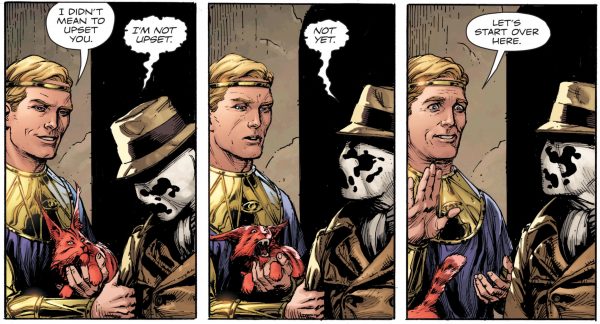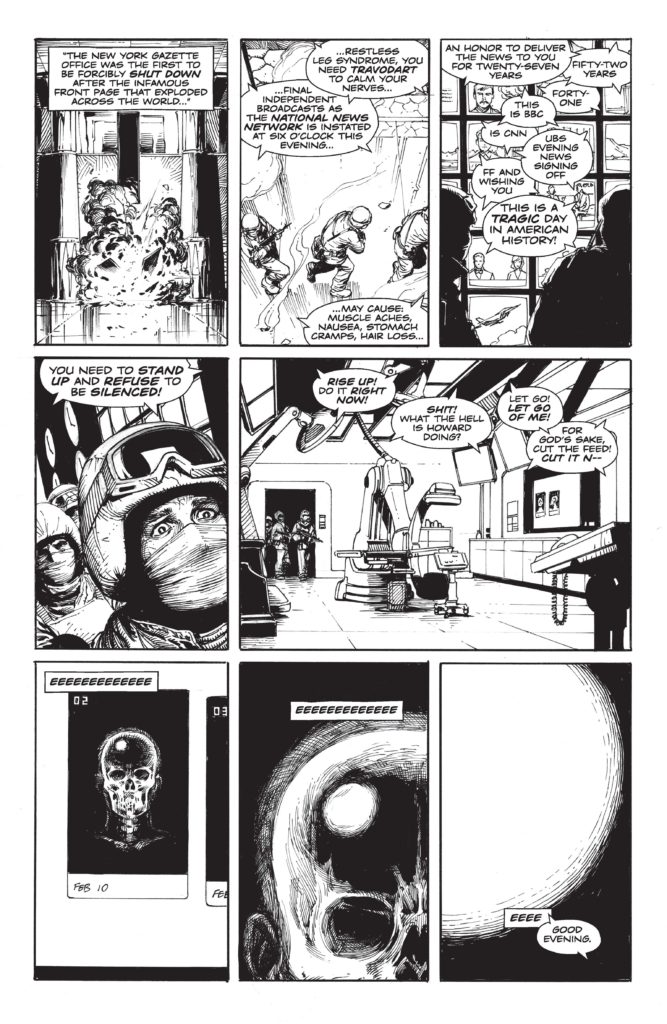
Buy this series. Seriously. Buy every issue. Track them down and buy them.
We can almost end this review right here, but there’s so much to parse through with this opening salvo of what is already one of my favorite comics this year. It takes a lot to get me excited for any reboot, and even moreso with comic events — crossover or otherwise — of any kind at all. But with Doomsday Clock, DC’s highly anticipated 12-issue maxi-series event, I’m all in. This is exactly the sort of story that is right up my alley, and the sort of meta-constructive criticism that I’d thought had all but died in the 1990s.
DC’s been teasing this event since the first issue of the “Rebirth” event (the DC universe crossing over with the Watchmen universe), and from then on it’s been one giant leap to the next. This was followed up with the four-issue Flash/Batman crossover “The Button” that spanned issues 24-25 of both those respective titles, with Eobard Thawne coming face-to-face with “God”…and judging from the otherworldly blue glow in that story, it wasn’t hard to guess the identity of “God”.
Doomsday Clock #1 opens on 1992 of the Watchmen universe: Ozymandias’ orchestrations have been revealed to the public, and the Soviet Union is preemptively taking advantage of the confusion and outrage the world is experiencing by moving into Poland. Missiles are flying, Ozymandias and his compatriots are nowhere to be found, and in the midst of this a riot is breaking out at a jail facility that being abandoned. And into this fray, as intimidating as ever, to break out the mother/father team the Marionette and her partner, the Mime, enters none other than Rorschach. Yep. And from his first line, Geoff Johns gets his character absolutely right (although, no, it isn’t the “real” Rorschach…nor is it too hard to take a good guess at who this iteration might be).
Out to find Ozymandias, and the other members of the Minutemen, Rorschach leads his new compatriots to the abandoned hideout of the Nite Owl II. And from there, we move to Smallville, where the Man of Steel experiences his first nightmare that he can remember.
It’s a hell of a start.
I’ve got to give credit to artist Gary Frank: this comic looks gorgeous. As much a natural progression of where Dave Gibbons would probably have evolved with the Watchmen universe had it continued, these pages are luscious with detail, and several times I’d stopped to admire not only the details of each panel, but the composition, lighting, use of color, and even the page layout. It is reminiscent of a less painterly Glenn Fabry, but seeing as Fabry is one of my favorite comics artists, I was delighted. Several instances also reminded my of Darick Robertson’s amazing work on The Boys, particularly when it came to inserting details that breathed a richer life onto the page. Frank and Johns are playing a long game: they know how to slow the action down, let the characters breath, and are using this maxiseries to actually tell a capital-S Story. This is a deliberately paced story, just as the original Watchmen was, and it is amazing that a story this well-written and developed is coming out of the main DC Universe.
This is no “Event For Its Own Sake”, but a natural reconstruction of the very tropes that Watchmen had deconstructed, and that nearly every comic series for the past nearly 20 years had never bothered to rebuild. Less a crossover for its own sake, the combination of the DC Universe with the Watchmen universe (which itself was built due to the rights of certain DC and Charlton characters being off-limits) is a refutation of the very mistakes of which DC in particular had found itself guilty. Moreover, Doomsday Clock is commenting on all of these editorial decisions that have contributed to the boom/bust cycle that has been threatening the industry the past few years. Watchmen blew apart the comics industry into something grittier, darker, more self-aware, and more “serious”…and it never moved past that; it was the narrative marker upon which the industry rested its laurels, never moving on to analyze, really, how it affected the entire industry.
This is exactly the sort of story we need now; not just socially, but within the industry itself. Just as the DCEU is slowly course-correcting, Doomsday Clock already feels a necessary course-correction back to the optimism and genuine heroism of which the DC Universe has always represented (and given the amount of talent moving into the house of the Distinguished Competition, it seems that this trend will only continue). Johns has keyed into a thematic through-line here, and this series seems laser-focused on this meta-commentary between the stories we try convincing ourselves we want, and the stories that are genuinely worth telling.
Doomsday Clock is both of those things.
I cannot possibly recommend this any more. Everything about this crossover…from “Rebirth” to “The Button”, to every single issue in this maxiseries…is begging for you to buy it, reread it, study it, and embrace it.

-J.L. Caraballo




